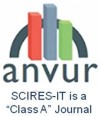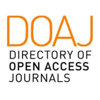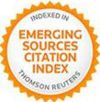Abstract
Keywords
Full Text:
PDFDOI: http://dx.doi.org/10.2423/i22394303v12n2p87
References
Agapiou, A., Vionis, A., & Papantoniou, G. (2021). Detection of Archaeological surface ceramics using deep learning imagebased methods and very high-resolution UAV imageries. Land, 10(12), 1365. https://doi.org/10.3390/land10121365
Beaufrère, P., Dabas, M., Décriaud, J., & Tabbagh, A. (1999). Application de la thermographie aéroportée à la prospection archéologique. Revue archéologique de Picardie. Numéro spécial 17, 289-293.
Bernus, E., & Poncet, Y. (1981). Etude exploratoire du milieu naturel par télédétection, plaine de l'Eghazer. , Paris: Orstom. Bonhage, A., Eltaher, M., Raab, T., Breuß, M., Raab, A., & Schneider, A. (2021). A Modified Mask Region-Based Convolutional Neural Network Approach for the Automated Detection of Archaeological Sites on High-Resolution Light Detection and Ranging-Derived Digital Elevation Models in the North German Lowland. Archaeological Prospection, 28(2), 177-186. https://doi.org/10.1002/arp.1806 Calastrenc, C., Baleux, F., Poirier, N., Rendu, C. (2020). Thermographie aéroportée par drone. Nouvelle procédure pour la détection archéologique en haute montagne. ArcheoSciences, 44 (1), 81-96.
Caspari, G., & Crespo, P. (2019). Convolutional neural networks for archaeological site detection -Finding “princely” tombs. Journal of Archaeological Science, 110(1), 1-25. https://doi.org/10.1016/j.jas.2019.104998
Ceraudo, G. (2010), 100 anni di archeologia aerea in Italia. Atti del Convegno Internazionale, Roma, 15-17 aprile 2009. Studi di Aerotopografia Archeologica, Archeologia Aera 4/10. Roma: Claudio Grenzi Editore.
Chaidron, C., Clotuche, R., & Willems, S. (2017). La céramique «militaire» dans le Nord de la Gaule de la Conquête au début du IIe siècle après J.-C.: Faciès et particularités. Hodgsob, N., Bidwelle, P., Schachtmann, J. In Proceedings of the XXI Internation Congress of Roman Frontier Studies (Limes Congress) held at Newcastle upon Tyne un August 2. (pp. 221-228). Oxford: ArchaeOpress Publishing LTD.
Clotuche, R., Chaidron, C., Comont, A., Dubois, S., & Willems, S. (2010). Les productions septentrionales (Nord-Pas-de-Calais et Picardie): détermination des faciès culturels et analyse des diffusions. In Actes du congrès de Chelles, SFECAG, Marseille (pp. 171-187).
De Laet, S. J., & Thoen, H. (1969). Etudes sur la céramique de la nécropole gallo-romaine de Blicquy (Hainaut): IV. La céramique «à enduit rouge-pompéien». Helinium, 9, 28-38.
De Laet, V., Paulissen, E., & Waelkens, M. (2007). Methods for the extraction of archaeological features from very high-resolution Ikonos-2 remote sensing imagery, Hisar (southwest Turkey). Journal of Archaeological Science, 34, 830-841. Déodat, L., & Lecoq, P. (2009). Images satellitaires et prospection archéologique. Les nouvelles de l'archéologie, 117, 57-64.
Eppelbaum, L. (2009). Near-surface temperature survey: An independent tool for delineation of buried archaeological targets. Journal of Cultural Heritage, 10 ( Supplement 1), 93-103. Garrison, T. G., Houston, S. D., Golden, C., & Inomota, T. (2008). Evaluating the use of Ikonos satellite imagery in lowland Maya settlement archaeology. Journal of Archaeological Science, 35, 2770-2777.
Goguey, R., & Cordier, A. (2015). Photographie aérienne et archéologie. Une aventure sur les traces de l’Humanité. Infolio ed.
Goossens, R., de Wulf, A., Bourgeois, J., Gheyle, W., & Willems, T. (2008). Satellite imagery and archaeology: the example of Corona in the Altai Mountains. Journal of Archaeological Science, 33, 745-755.
Goudineau, C. (1968). La céramique arétine lisse. E.F.R. supp. 6, tome IV, Rome.
Hawkes, C. F. C., & Hull, M. R. (1947). Camulodunum: first report on the excavations at Colchester, 1930-1939. (Reports of the Research Committee of the Society of Antiquaries of London, No. XIV). Oxford: University Press,
Henton, A., Fourny, M., Van Assche, M., & Clarys, B. (2016). Ortho-photographie de haute altitude et imagerie LiDAR, de nouveaux outils de prospection pour la recherche protohistorique en Wallonie (Belgique). Lunula. Archaeologia protohistorica, XXIV, 3-12.
Henton, A., & Hannois, P. (2014). Prospection archéologique par ortho-photographies aériennes et images satellitaires en Nord – Pas-de-Calais (France). Perspectives et données récentes pour l'âge du Bronze. Lunula. Archaeologia protohistorica, XXII, 23-31.
Karamitrou, A., Sturt, F., Bogiatzis, P., & Beresford-Jones, D. (2022). Towards the use of artificial intelligence deep learning networks for detection of archaeological sites. Surface Topography: Metrology and Properties, 10(4), 1-16. Retrieved from https://ui.adsabs.harvard.edu/link_gateway/2022SuTMP.10d4001K/doi:10.1088/2051-672X/ac9492
Küçükdemirci, M., & Sarris, A. (2020). Deep learning based automated analysis of archaeo-geophysical images. Archaeological Prospection, 27(2), 107-118. https://doi.org/10.1002/arp.1763
Orengo, H. A., Conesa, F. C., Garcia-Molsosa, A., Lobo, A., Green, A. S., Madella, M., & Petrie, C. A. (2020). Automated detection of archaeological mounds using machine-learning classification of multisensor and multitemporal satellite data. Proc. of the National Academy of Sciences of the United States of America, 117(31), 18240-18250. https://doi.org/10.1073/pnas.2005583117
Parpworth-Reynolds, R. (2019). Use case: How Bing Maps satellite imagery finds ancient sites. Code Matters, 11/01/2019. https://codematters.online/how-bing-maps-satellite-imagery-finds-ancient-sites/
Peacock, D.P-S. (1977). Pompeian Red Ware. In Pottery and Early Commerce: Characterisation and Trade, (pp.147-161). London: Academic Press.
Picon, M. (1973). Introduction à l’étude technique des céramiques sigillées de Lezoux. Dijon: Centre de Recherches sur les Techniques Gréco-romaines. Poncet, Y. (1985). Télédétection et archéologie à échelle régionale: une opération sur les données Landsat. Revue d'Archéométrie, 9, 7-18.
Rahrig, M., Drewello, R., & Lazzeri, A. (2018). Opto-technical Monitoring. A Standadized Methodology to Asses the Traitment of Historical Stone Surfaces. ISPRS TC II Mid-term Symposium “Towards Photogrammetry 2020”, 4–7 June 2018, Riva del Garda (Italy), The International Archives of the Photogrammetry, Remote Sensing and Spatial Information Sciences, XLII (2), 945-952.
Rapport de synthèse et prospective de l’archéologie française, présidé par Francfort, H.-P., Membres du comité André-Salvini, B., Boissavitt-Camus, B., Brosseder, U., Carre, M.-B., Depaepe, P., Forestier, H., Guilaine, J., & Walter, P., Coordonné par le conseiller scientifique Galderisi, C., HCÉRES, 2019. Rigby, V., & Freestone, I. (1986). The petrology and typology of the earliest identified Central Gaulish imports. Journal of Roman Pottery Studies, 1, 6-21. Soroush, M., Mehrtash, A., Khazraee, E., & Ur, J.A. (2020). Deep Learning in Archaeological Remote Sensing: Automated Qanat Detection in the Kurdistan Region of Iraq. Remote Sensing, 12(3), 500. https://doi.org/10.3390/rs12030500
Tomber, R., & Dore, J. (1998). The National Roman Fabric Reference Collection. A Handbook. MoLAS Monograph 2, Museum of London, Archaeology Service, English Heritage, British Museum, London.
Article Metrics
Metrics powered by PLOS ALM
Refbacks
- There are currently no refbacks.
Copyright (c) 2023 Cyrille CHAIDRON, Sébastien LERMENIER

This work is licensed under a Creative Commons Attribution-NonCommercial-NoDerivatives 4.0 International License.
SCIRES-IT, e-ISSN 2239-4303
Journal founded by Virginia Valzano






